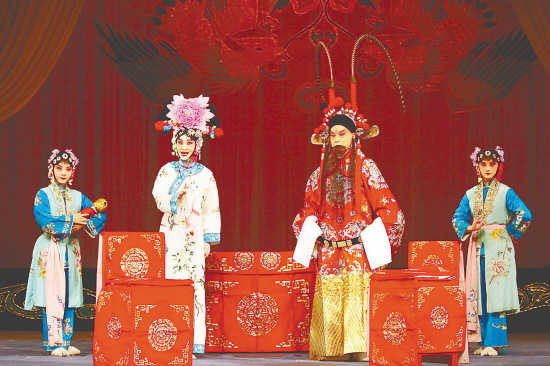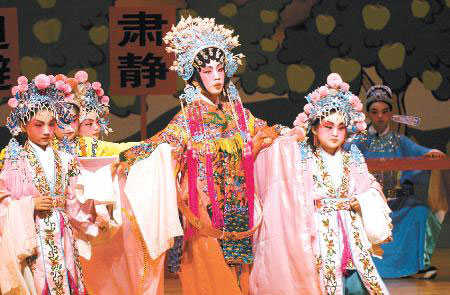# Exploring Guangzhou’s Cantonese Opera and Cultural Heritage
Welcome to Jusha Travel, your go-to source for uncovering the hidden gems of China! If you’re a traveler eager to dive into Guangzhou cultural traditions, you’re in for a treat. In this post, we’ll explore Guangzhou Cantonese Opera, a vibrant art form that embodies China’s rich China opera history. From its ancient roots to modern performances, Cantonese opera offers a window into cultural attractions Guangzhou has to offer, making it a must-see for anyone following a Guangzhou travel guide or planning China cultural tours. Whether you’re a culture enthusiast or a curious adventurer, experiencing this theatrical tradition can make your China journey unforgettable. Here at Jusha Travel, we love sharing tips to make your China journey unforgettable!

## Historical Origins of Cantonese Opera in Guangzhou
Cantonese opera, often hailed as the soul of Guangzhou cultural traditions, has a fascinating backstory that dates back centuries. Its roots can be traced to the 16th century during the Ming dynasty, specifically under Emperor Jiajing’s reign (1522–1566) [Hong Kong Memory – The Origin of Cantonese Opera](https://www.hkmemory.hk/collections/ichhk/opera/origin/index.html). This art form evolved from earlier theatrical traditions, such as Nanxi or Southern drama, which were brought to Guangdong by refugees fleeing the Song dynasty’s fall. As northern influences merged with local customs, Cantonese opera blossomed into a unique expression of China opera history.
By the 13th century, during the Yuan dynasty, population movements due to Mongol invasions helped spread these traditions southward, where they adapted to the Lingnan region’s vibrant culture [Cantonese opera – Wikipedia](https://en.wikipedia.org/wiki/Cantonese_opera). Initially centered in Foshan, the art form shifted to Guangzhou amid political changes, establishing the city as a hub for innovation. Over time, it absorbed elements from various genres, including Yiyangqiang and Kunqiang, blending them with regional folk styles to create something distinctly Cantonese.
For travelers on a Guangzhou travel guide, understanding this history adds depth to your visit. Imagine wandering through Guangzhou’s historic districts, where echoes of ancient performances linger. One practical tip: Visit the Guangzhou Cantonese Opera Art Museum to see artifacts and reenactments. As you plan your China cultural tours, consider timing your trip with festivals, where you might catch a live show. This not only immerses you in the culture but also highlights how opera has influenced everyday life, from moral tales to community gatherings.

## Defining Artistic Features of Cantonese Opera
What makes Guangzhou Cantonese Opera so captivating? This art form is a masterful fusion of drama, music, singing, martial arts, and acrobatics, setting it apart in the tapestry of China opera history [Cantonese Opera Artistry: Delving into the Beauty of China’s Intangible Cultural Heritage](https://www.lingoace.com/blog/cantonese-opera-artistry-delving-into-the-beauty-of-chinas-intangible-cultural-heritage-en/). Performances feature elaborate costumes and makeup, where colors symbolize character traits—red for loyalty, white for treachery—making each show a visual feast.
The vocal style is particularly distinctive, with singers using a melodic Cantonese dialect that draws from regional folk narratives and classical literature [Modernising Cantonese Opera through contemporary…](https://repository.mdx.ac.uk/download/b95fe686d39564a31fb044d82b00f14c7b2e1323e902bb78fc587655bce6ae7c/5577469/LGRLin%20thesis.pdf). Accompaniment includes a symphony of instruments like erhu strings, bamboo flutes, and percussive gongs, creating a dynamic interplay between “civil” (wenchang) and “martial” (wuchang) elements. Traditionally, all roles, including female ones, were played by men, a practice that persisted until the 20th century, reflecting the era’s social norms.
For culture enthusiasts visiting cultural attractions Guangzhou, attending a performance is like stepping into a living history book. Practical advice: Opt for an interactive workshop to learn basic gestures or makeup techniques—it’s a fun way to engage with the art. If you’re on a China cultural tours, pair this with exploring Guangzhou’s food scene; dim sum teas were historically enjoyed during opera intermissions, blending culinary and theatrical traditions. Fun fact: Cantonese opera’s acrobatic flips and fight scenes have influenced modern Chinese cinema, showcasing how technology and performance arts intersect in today’s China.

## Cantonese Opera’s Role in Guangzhou Cultural Life
Guangzhou Cantonese Opera isn’t just entertainment—it’s the heartbeat of Guangzhou cultural traditions, woven into the fabric of daily life and community events [Hong Kong Memory – The Origin of Cantonese Opera](https://www.hkmemory.hk/collections/ichhk/opera/origin/index.html). Historically, opera houses and tea houses served as social hubs where people from all backgrounds gathered, fostering a sense of unity. The establishment of guilds like the Pak Wo Association in 1889 helped professionalize the art, ensuring its transmission across generations.
This tradition often aligned with festivals, such as the Mid-Autumn Festival, where performances celebrated themes of loyalty, filial piety, and justice, acting as moral guides [Cantonese opera – Wikipedia](https://en.wikipedia.org/wiki/Cantonese_opera). In Guangzhou, local elites and merchants played a key role in patronage, supporting troupes that toured both domestically and abroad, spreading China opera history to diaspora communities.
As a traveler, incorporating Guangzhou travel guide insights means experiencing this firsthand. Visit venues like the historic opera theaters for a show, and don’t miss the chance to try local snacks like roasted chestnuts or herbal teas sold outside—it’s a nod to how food and culture intertwine in China. For those on China cultural tours, consider a guided walk through neighborhoods where opera influenced architecture and public spaces. An interesting fact: During the Cultural Revolution, opera faced suppression but rebounded, symbolizing resilience and the enduring spirit of Chinese heritage.
## Contemporary Developments and Preservation Efforts
In today’s fast-paced world, Guangzhou Cantonese Opera is evolving to stay relevant, with innovative preservation efforts ensuring its place among cultural attractions Guangzhou [The Origins of Cantonese Opera – City University of Hong Kong](https://www.cityu.edu.hk/lib/about/event/cantonese_opera/origins.htm). Recognized by UNESCO as an Intangible Cultural Heritage in 2009, the art form is undergoing a revival through educational programs, digital archives, and modern adaptations [Cantonese Opera Artistry: Delving into the Beauty of China’s Intangible Cultural Heritage](https://www.lingoace.com/blog/cantonese-opera-artistry-delving-into-the-beauty-of-chinas-intangible-cultural-heritage-en/).
In Guangzhou, initiatives include school workshops and collaborations with technology, like virtual reality shows that blend traditional storytelling with cutting-edge effects. The Guangzhou Cantonese Opera Art Museum hosts annual festivals, drawing global audiences and training new talents [Modernising Cantonese Opera through contemporary…](https://repository.mdx.ac.uk/download/b95fe686d39564a31fb044d82b00f14c7b2e1323e902bb78fc587655bce6ae7c/5577469/LGRLin%20thesis.pdf). These efforts not only preserve the core but also attract younger crowds by updating storylines with contemporary themes.
For travelers, this means more accessible experiences on your China cultural tours. Tip: Download apps for virtual opera tours or join online classes before your trip—it’s a tech-savvy way to prepare. As China embraces innovation, Cantonese opera exemplifies how tradition and modernity coexist, much like the fusion of ancient customs with today’s digital age.
In conclusion, delving into Guangzhou Cantonese Opera reveals the depth of Guangzhou cultural traditions and China opera history, offering unforgettable insights for any cultural attractions Guangzhou itinerary or Guangzhou travel guide. From its historical origins to contemporary twists, this art form inspires a greater appreciation for China cultural tours, connecting us to the heart of Chinese heritage. Here at Jusha Travel, we’re passionate about guiding you through these experiences to create lasting memories. We encourage you to share your thoughts in the comments below, visit jusha.travel for more inspiring China travel content, or explore our related articles on other cultural gems. What’s your favorite cultural tradition in China? Let’s keep the conversation going!

